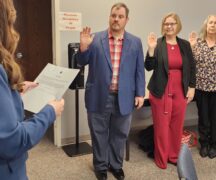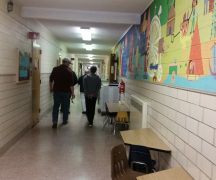By JAN LARSON McLAUGHLIN
BG Independent News
After years of dyslexia going undiagnosed for many struggling readers, Ohio educators are stressing the need to help more young readers decode the words on the page.
In 2021, Gov. Mike DeWine signed House Bill 426 into law, imposing significant new requirements on districts to identify and educate students who may have dyslexia.
Following Ohio’s Dyslexia Guidebook, Bowling Green City Schools has developed a program to screen students for dyslexia, and train teachers to help students unlock the secrets to their specific type and range of dyslexia.
“All brains go through the same process when they are learning to read,” said Angie Schaal, executive director of teaching and learning for Bowling Green City Schools.
But due to neuro-biologic differences, some readers have difficulty decoding language. With the right instruction, the vast majority of people with dyslexia will learn to read, but it requires different strategies for them than a neurotypical reader.
Dyslexia has been likened to reading in a foreign language that has not been mastered – it is slower, takes more effort, and is mentally draining.
Schaal said as many as one in five students are believed to have some range of dyslexia.
For some children, learning to read is extremely difficult and becomes a barrier to their academic and social-emotional development. A large and converging body of research now shows that early identification of children who may experience reading difficulties is possible and focused intervention and remediation efforts can be effective for reducing negative long-term impacts.
“It is about how the brain is processing language,” Schaal said. “When you know more, you do more. So we have the right fit for the kid.”
“It gives you a wealth of knowledge about why students do certain things,” she said. “It’s looking at things through a new lens. It’s an exciting opportunity.”
Dyslexia is not something that is cured, but in most cases people with dyslexia build creative skills to compensate throughout their lives.
Beginning in the 2022-2023 school year, districts will be required to establish a multi-sensory structured literacy certification process for teachers of students in grades K-3.
“Eventually, it’s all teachers,” Schaal said.
The Ohio Dyslexia Guidebook offers methods for universal screening, intervention and remediation.
The approach provides instruction for helping children understand the connections between sounds and letters – a concept referred to as the alphabetic principle. Children use this knowledge to map speech to print in order to spell, pronounce and store the meaning of words in their memory.
Ohio’s Plan to Raise Literacy Achievement calls for schools to partner with families to use assessments and curriculum to meet the needs of all learners, including students with dyslexia.
Ohio defines dyslexia as “a specific learning disorder that is neurological in origin and that is characterized by unexpected difficulties with accurate or fluent word recognition and by poor spelling and decoding abilities not consistent with the person’s intelligence, motivation and sensory capabilities, which difficulties typically result from a deficit in the phonological component of language.”
Students with dyslexia tend to have difficulty processing speech sounds, decoding words and reading fluently. Such difficulties often lead to slow and inaccurate reading, inadequate comprehension and difficulty with written or spoken language.
Myths and misunderstandings about dyslexia are prevalent and persistent.
Students with the below behaviors do not necessarily have dyslexia and will not necessarily be identified in the future as having dyslexia. However, if the below characteristics are unexpected for a student’s age or education level, if they persist over time despite generally effective instruction and if they interfere with learning, they may be associated with dyslexia.
The following list outlines risk factors for dyslexia across the age/grade level. Watch for difficulty with:
Birth-Kindergarten Entry
• Learning to speak
• Learning nursery rhymes
• Identifying initial sounds in words
• Learning letter names, colors, numbers, days of the week
• Pronouncing familiar words
• Retrieving the correct word when speaking
• Telling a story in sequence
• Following multistep directions
• Not making progress despite generally effective instruction
Early Elementary
• Recognizing, producing and working with individual sounds (phonemes) in spoken words
• Confusion of visually similar letters or letters that represent sounds that are similar
• Learning the relationships between sounds and letters
• Learning to decode
• Reading out loud
• Retrieving words when speaking
• Pronouncing long, difficult, or complicated words
• Spelling
• Handwriting/letter formation
• Not making progress despite generally effective instruction
Later Elementary
• Organizing written and spoken language
• Reading multisyllabic words
• Reading common irregular words
• Reading text fluently enough to support comprehension
• Spending time reading
• Reading out loud
• Retrieving words when speaking
• Spelling and writing
• Handwriting
• Not making progress despite generally effective instruction
Middle and High School
• Organizing written and spoken language
• Reading text fluently enough to support comprehension
• Expressing ideas verbally
• Spending time reading
• Reading out loud
• Learning a foreign language
• Managing homework
• Taking notes in class
• Spelling and writing
• Not making progress despite generally effective instruction





